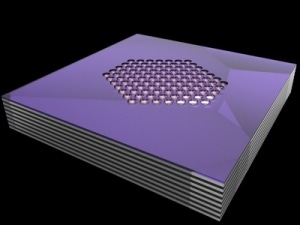May 8 2017
 Image of photonic hypercrystals courtesy of Tal Galfsky
Image of photonic hypercrystals courtesy of Tal Galfsky
Control of light-matter interaction plays a significant role in fundamental phenomena and technologies such as solar cells, LEDs, lasers and photosynthesis. Photonic hypercrystals, a new class of artificial media, were recently demonstrated by City College of New York researchers. These photonic hypercrystals are capable of controlling light-matter interaction in exceptional ways.
According to Vinod M. Menon, professor of physics in City College’s Division of Science who headed the research, this could result in benefits such as development of single photon emitters for quantum information processing, enhanced absorption in solar cells and ultrafast LEDs for Li-Fi (a wireless technology that transmits high-speed data using visible light communication).
Two common artificial materials used to manipulate light are photonic crystals and metamaterials. However, these artificial materials have their own disadvantages such as poor light emission and bandwidth limitation. Menon and his team, in their research, overcame these drawbacks by producing hypercrystals capable of taking on the best of both photonic crystals and metamaterials and performing a lot better. These researchers demonstrated major increase in both intensity and light emission rate from nanomaterials embedded inside the hypercrystals.
The emergent properties of the hypercrystals develop from the exceptional combination of the inherent properties of the nanoscale structures and length scales of the features in the hypercrystal.
The CCNY research has been published in the most recent issue of the Proceedings of the National Academy of Sciences. The team included graduate students Tal Galfsky and Jie Gu from Menon’s research group in CCNY’s Physics Department and Evgenii Narimanov (Purdue University), who first theoretically predicted the hypercrystals. The Army Research Office, the National Science Foundation – Division of Materials Research MRSEC program, and the Gordon and Betty Moore Foundation supported the research.